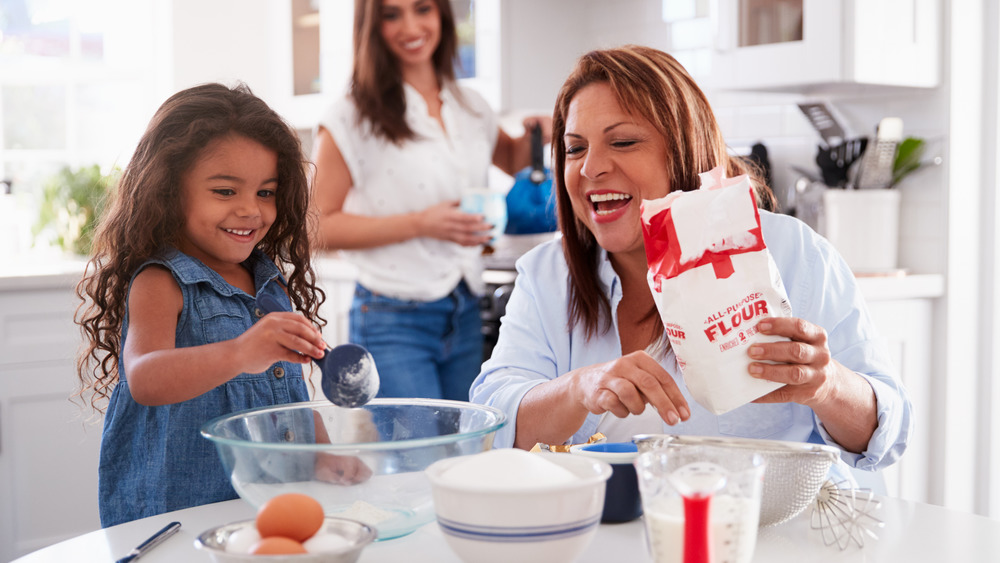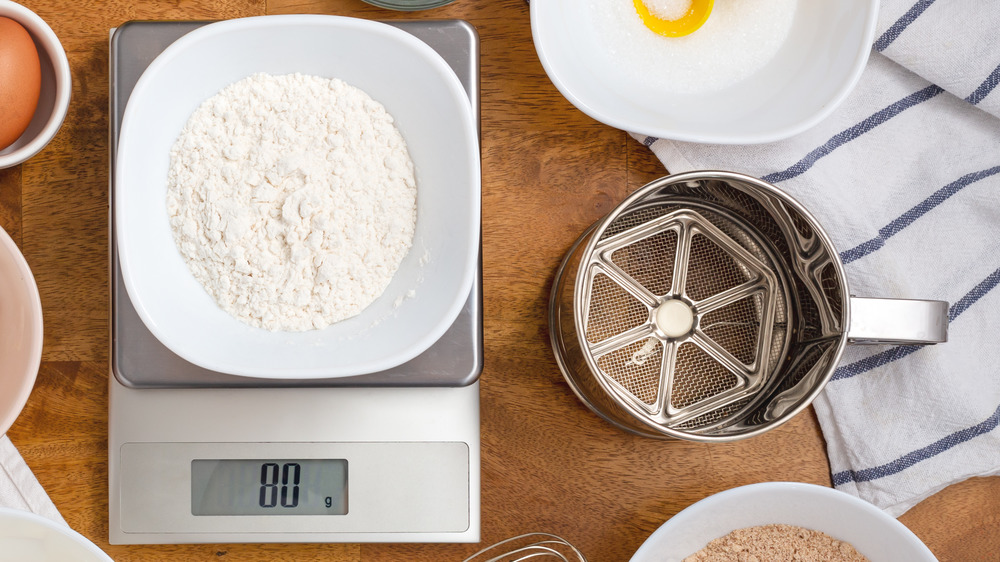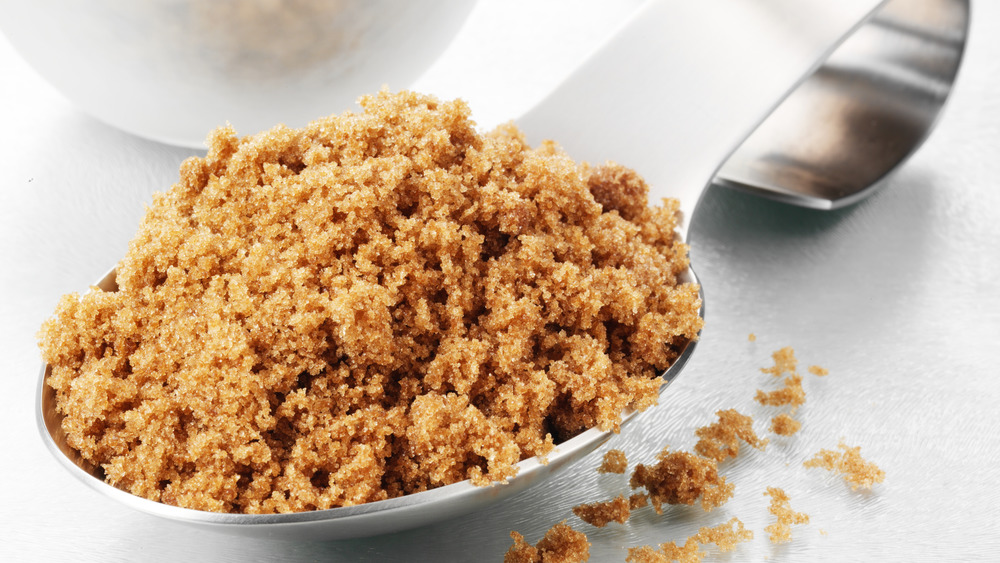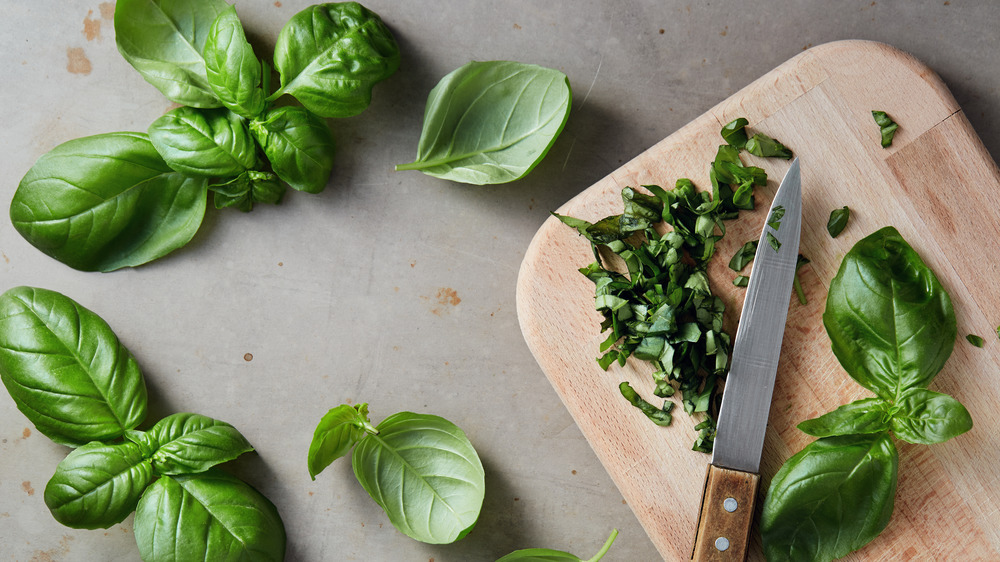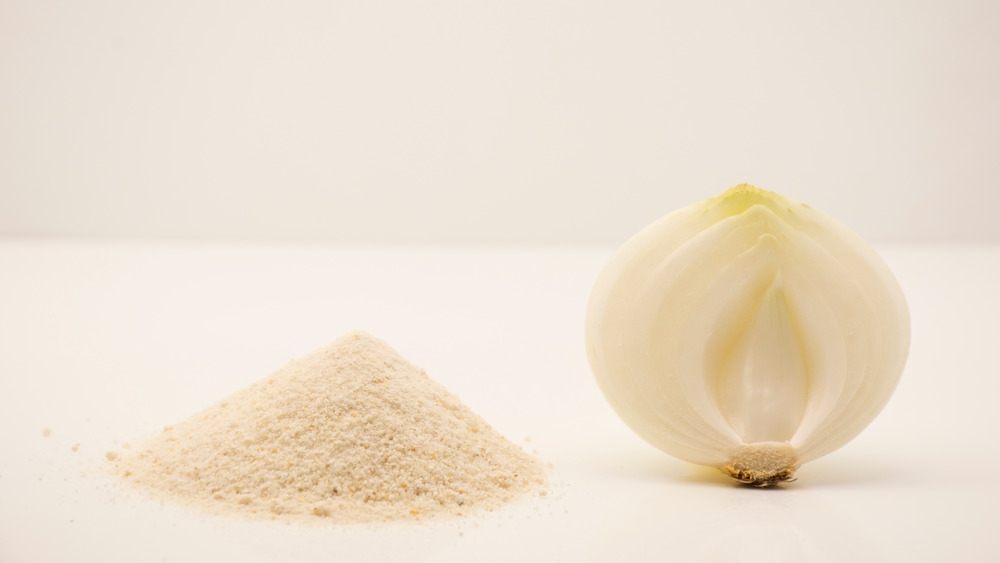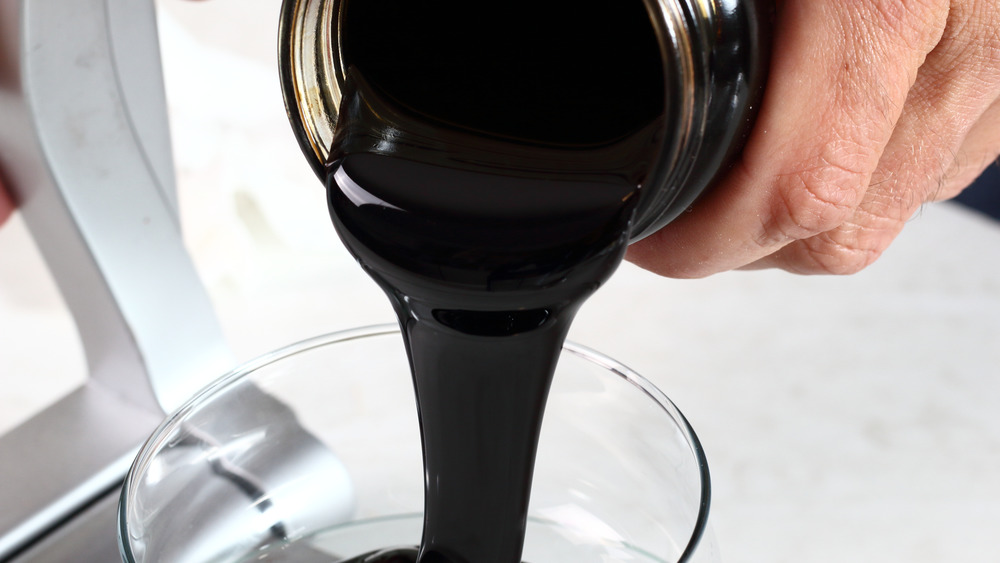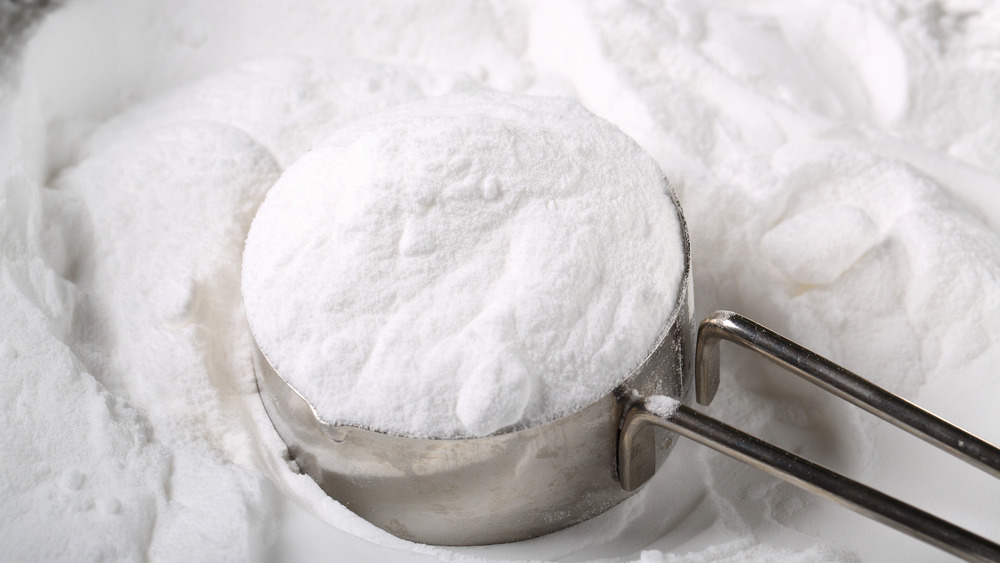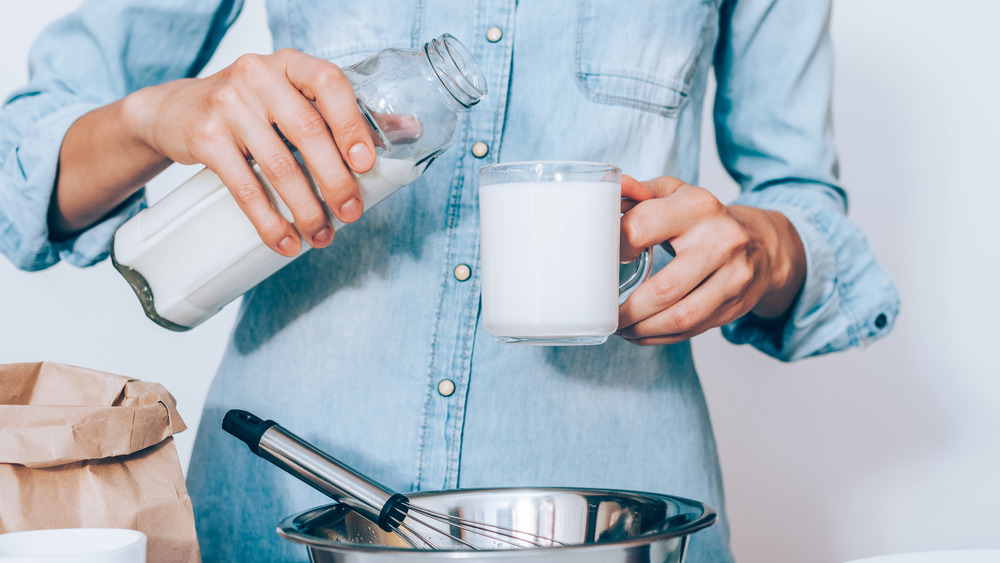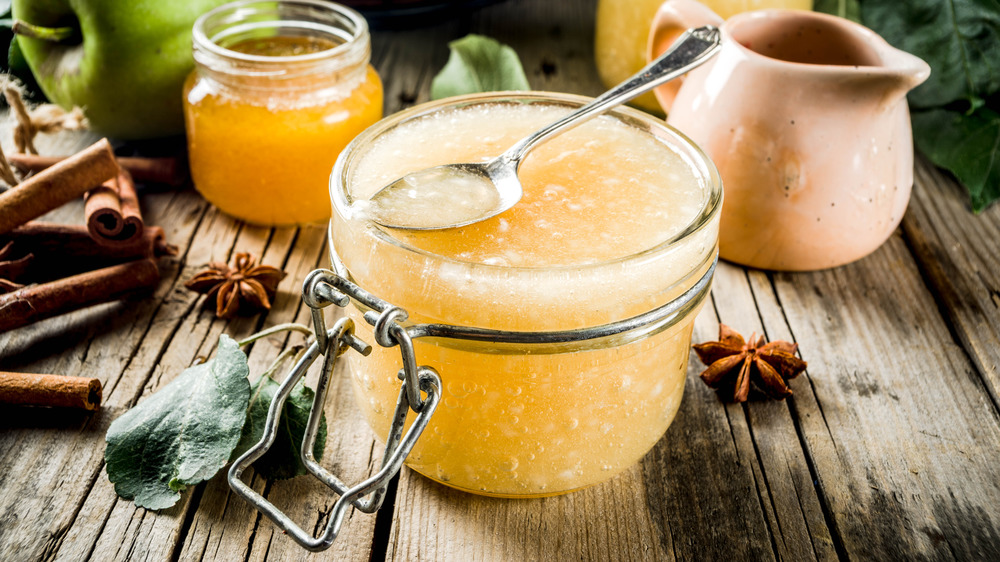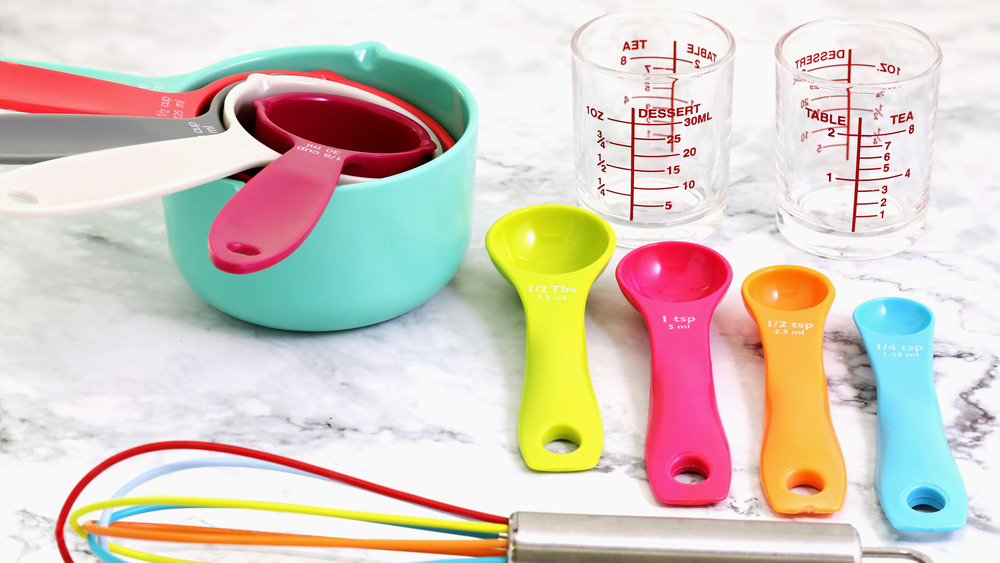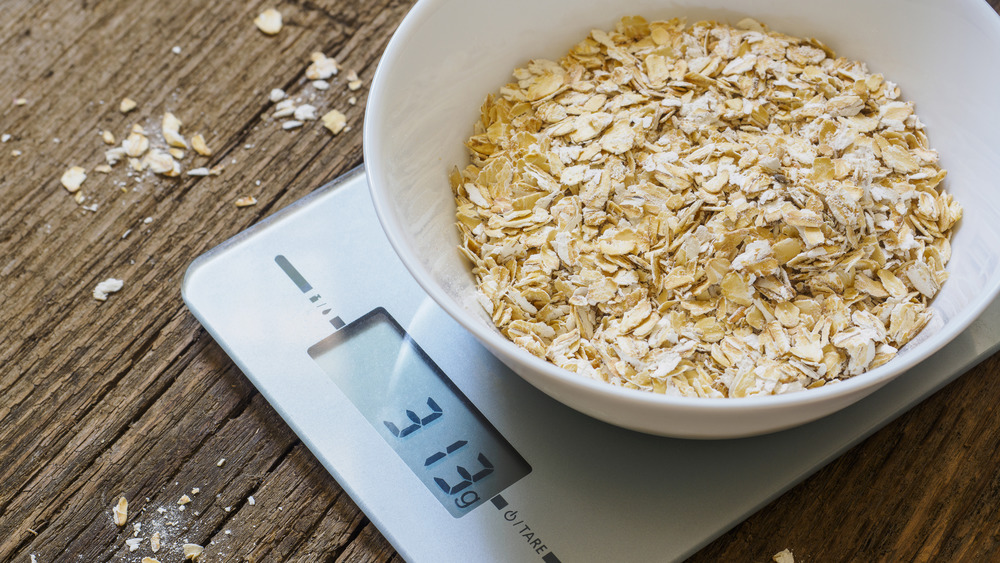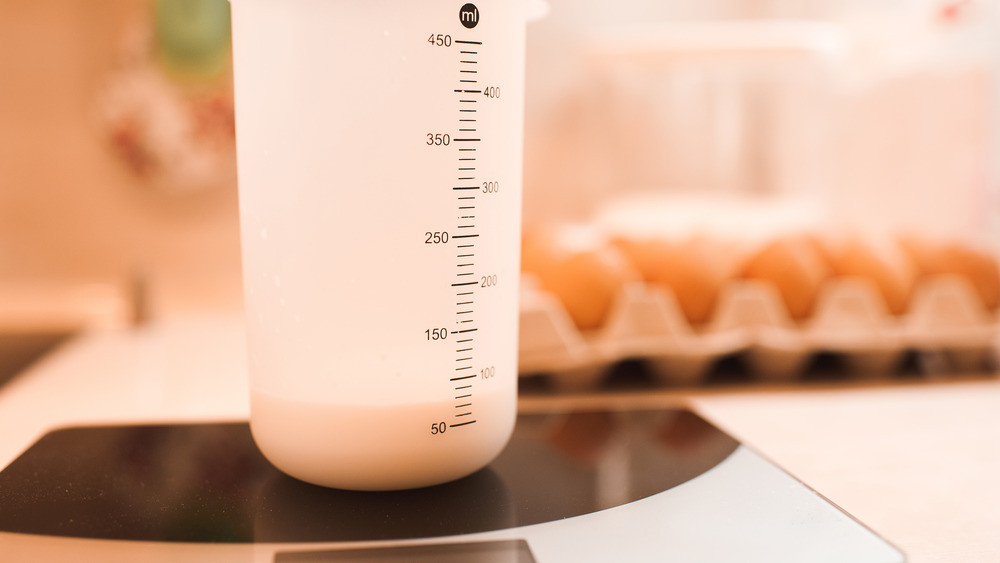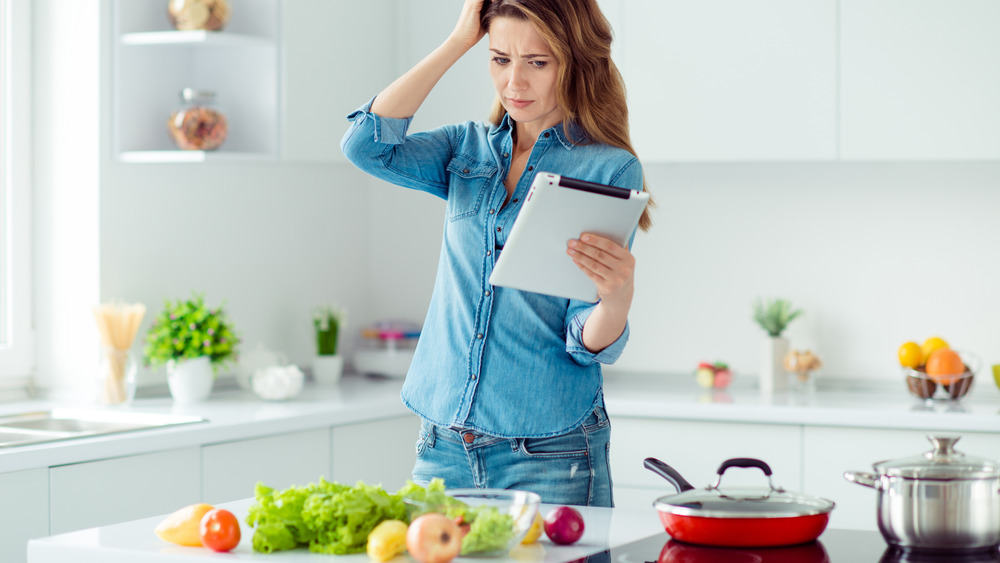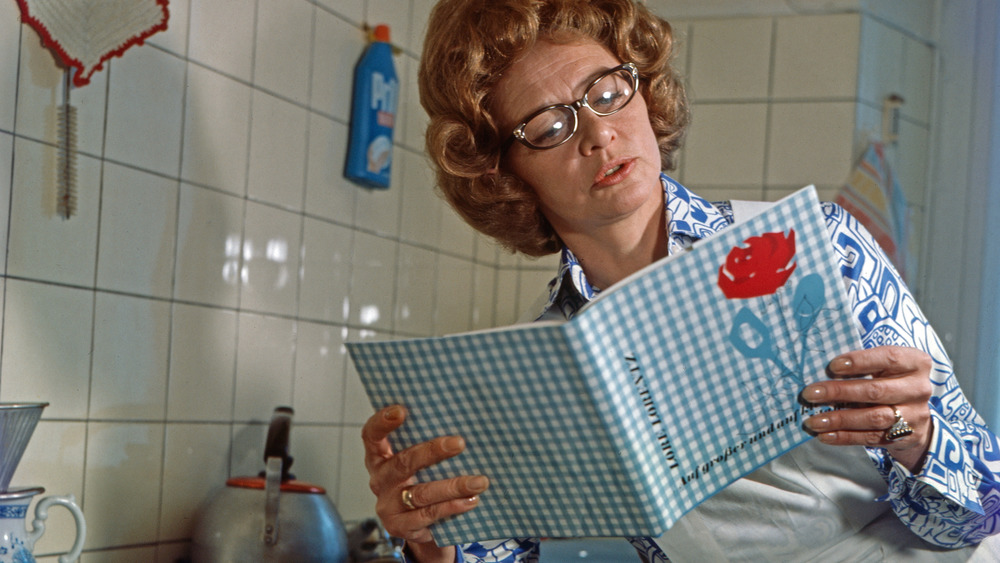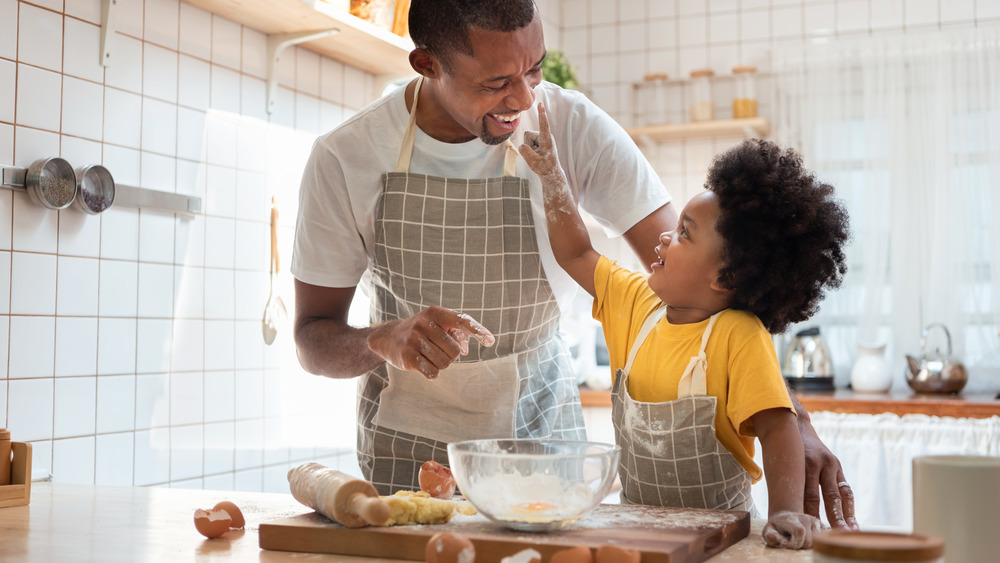Mistakes Everyone Makes Measuring Ingredients
We all know those people, the ones who can throw things into a pot, pan, or bowl seemingly at random and have the final thing come out amazing. Those people are not normal.
Look at it this way: if they were, there would be no need for recipes. There would be no need for things like measuring cups and spoons, and there would certainly be no need for things like scales. And all of those are staples in pretty much every kitchen, but here's the thing — having them close at hand is only half the battle.
You'll also need to know how to use them, and it's something that seems deceptively simple. You just pour things to the line, then dump ... right?
Not quite. If you've noticed your baking projects haven't come out quite as planned, that curry didn't have the perfect amount of spice, or your attempt at recreating that recipe you spotted online didn't look anything like the photo, you might be measuring wrong. It's easy to do, and here's how you fix it.
There's a lot of things you can do wrong with flour
Flour is a super basic ingredient, so it's worth talking about on its own — because there's a lot that can go wrong with measuring it. Take an experiment from Taste of Home. They asked their staff to measure out a cup of flour, then weighed the results. The cups actually varied from 3 ounces to 5.5 ounces — and that would explain ruined cookies!
So, how do you prevent this from happening? For starters, make sure you're not packing your flour down tight — which means stirring it to loosen it up (or sifting it), then spooning it into your measuring device. Then, level the measuring cup with the flat side of a knife, and you should be pretty accurate.
If you want to be even more accurate, it's worth investing in a kitchen scale. Then, you know exactly how much flour you're getting, but it's possible to get this one wrong, too. Remember: different types of flour weigh different amounts. If a recipe calls for one cup of all-purpose flour, that equates to 125 grams. But, if you need a cup of cake flour, that's 140 grams. It's an easy trap to fall into!
Here's what you're messing up with brown sugar
Measuring granulated sugar is pretty straightforward, but when it comes to brown sugar, it's a little more complicated. Regular sugar is easy to pour, but brown sugar comes out in clumps — and it's easy enough just to scoop some out of the bag and move on.
But, you shouldn't. According to CH Sugar, recipes that call for brown sugar mean that your measurement should be all brown sugar — and that means no air pockets. The best way to make sure you're not getting any air is to get out your measuring cup, and instead of pouring, transfer the brown sugar one spoonful at a time. After each scoop, make sure it's packed down nice and tight before adding more. Then, don't forget to level it off at the top. It'll take a little longer, but aren't the perfect cookies worth it?
You don't know the tricks to measuring fresh herbs
The first mistake is thinking that a recipe that calls for "chopped basil" is different from one that calls for "basil, chopped." While one might seem to suggest you chop them measured — while the other suggests you measure, then cut — The Kitchn says that both ways are the same, and you can do whichever you're more comfortable with.
It's also easy to go too heavy or too light on the herbs, which brings us to another question: how tightly do you pack them in your measuring cup? The answer is simple — just take either your herb leaves, whole or chopped, put them into your container, and tap it on the counter. They'll settle, but won't be crushed.
You might also run into challenges measuring herbs for old-timey sorts of recipes that call out quantities in "parts." It's a common phrasing used in things like mixing your own tea blends, and a "part" simply means that you can choose how you measure. Whether it's in cups or tablespoons, The Herbal Academy says that as long as you keep the measurement unit the same, you're golden. Two parts rose petals and one part lemon balm, for example, will work whether you use two cups of rose petals and one cup of lemon balm, or two tablespoons of rose petals and one tablespoon of lemon balm.
You're measuring fresh and dried herbs in the same way
Fresh ingredients are great and all, but let's be honest — sometimes it's tough enough to find time to brush your teeth, much less muck about with going to the store to pick up a bunch of fresh herbs for dinner. When the recipe you're making calls for fresh and all you have on hand is dried, it'll work — as long as you don't forget to take into account the conversion standards for measuring.
One conversion covers most fresh-to-dried ingredients, and it's a simple one. For each tablespoon of fresh herbs that the recipe calls for, use one teaspoon of the dried stuff. If the measurements aren't that straightforward, don't worry. Another easy way to remember it is in the ratio of 3:1, fresh to dry.
There are some exceptions to the rule, and they generally happen when the fresh stuff is in a different form. Onions, for example: one medium onion is the equivalent to a teaspoon of onion powder. And basil and thyme are both a little stronger: for basil, you only need a ratio of 2:1, and for thyme, it's a ¾ teaspoon measure of the ground that will equal one tablespoon of the fresh (which is also equal to 6 sprigs).
You're not getting all your sticky ingredients out
Cooking and baking almost come with a guaranteed mess, and when you're making something that calls for something sticky like honey or molasses, that's almost enough to make you want to look for another recipe. Measuring them is a pain, and here's the thing — there's a good chance you're not getting the right amount of your ingredient in the bowl anyway.
Fortunately, Cuisine at Home says that there's a few simple tricks that you should absolutely be using any time you have to measure something like tahini, peanut butter, or any other similarly sticky and difficult ingredient.
First, you can line your measuring cup with plastic wrap for something that's going to hold together, like peanut butter. Measure as usual, pull out the plastic wrap, scrape, and that's it — it's all in the bowl, and there's no cleanup.
For stickiness like honey or molasses, reach for your nonstick cooking spray. Spray the inside of your measuring device — and this works whether you're using plastic or glass — and then fill, measure, and dump. It'll slide right out, and if it's still not quite working, dip your spatula in hot water before scraping — it'll minimize how much ingredients will stick, and when you measure a cup of something, a cup is what makes it in.
You're not leveling dry ingredients
Baking is a science and thinking back to science class, you'll remember that one of the things that was uber important was the exactness of measuring. A little bit off can make a big difference, and that's why not leveling off the top of your ingredients is a huge mistake.
According to Canadian Living, any dry ingredients you measure in a measuring cup should be leveled using the flat side of a knife. A heaping cup is going to throw your percentages off, and that'll cause problems.
Liquid ingredients are a little more complicated, and they say that in order to properly measure, you'll need to be at eye level. If you're looking down at, say, a glass measuring cup, the angle might make the level of liquid look accurate, even if it's really not. Lean down, check at eye level and make sure you're on the right spot.
You're not using the right measuring tools
For many of us, space is at a premium in the kitchen, and that means minimizing the amount of extra stuff you have laying around. A few complete sets of measuring cups might seem like a waste of space, but if you're using the same set for liquid and dry ingredients, Serious Eats says you're making a big mistake — and here's why.
That glass measuring cup you usually use for things like milk and water is specifically made for measuring liquids, and no matter how tempting it is to cut down on dishes and use it for flour, too, just don't. The lines on a fluid measuring cup are offset: when you pour in a liquid, the surface isn't flat. It's curved higher on the sides and dips lower in the middle, which liquid (or fluid) measuring cups account for. If you were to use the same thing for flour, your measurements would be way off.
How far off? That depends on the cup, but it's entirely possible you'd end up with about 150 percent of the amount you were actually trying to measure in the first place. Bottom line? Have separate measuring tools for liquid and dry ingredients.
Are they dry or liquid?
You're familiar with the difference between the measuring tools you need to use for dry and wet ingredients, and with most things, it's pretty obvious what you're going to reach for. Milk? Liquid. Water? Definitely a liquid. Flour and sugar? They're definitely dry.
But what about things like sour cream and yogurt? They're ... not liquids, but they're definitely not dry, either. What about applesauce? It's not clear at a glance, but it's easy to make the leap of logic that says they're more wet than they are dry, so you should use the liquid measurements, right?
Wrong. Better Homes & Gardens says that these in-between sort of ingredients should be treated as if they were dry, and you should use the same measuring cups you would for flour. Measure them kind of like you would measure flour, too: transfer them with a spoon, and don't forget to level them off.
You're assuming your measuring cups are right
Measuring cups literally have one job (unless you count holding the chocolate chips so you can sample as you bake). It's easy to assume that using a one-cup measuring cup is going to yield you a cup of something, but assuming that could be a mistake that's ruining your baking.
Journalists at The Washington Post's Food Lab did a simple experiment: they took two one-cup measuring cups, filled them each, then weighed what was in them. The difference between the two was half an ounce of flour, and given that any discrepancy is magnified when you're making a recipe that calls for 3 or 4 cups of flour, that adds up to recipe-breaking amounts.
They're not the only ones that have found huge inconsistencies in every kind of measuring device: liquid or dry, cup or spoon. In some cases, errors as much as 30 percent have been found, and the experts chalk it up to inaccuracies in the factories and the machines labeling your cups.
If you want accurate results, you can test your tools to see where they fall. It's fairly easy: just get some flour and a kitchen scale, and weigh what your cup says is a cup. King Arthur Baking says that a cup of all-purpose flour should weigh 4.5 ounces (120 grams), and if yours doesn't, that might be why your cakes aren't coming out well.
You've never measured baking ingredients by weight
Let's say you want to get really serious. Are you still using measuring cups? You shouldn't be.
Taste of Home notes that when it comes to the professionals, they opt for using a digital scale for measurements. That's for a few reasons, starting with the fact that weight is more reliable than volume for all kinds of different ingredients. Think of it this way: bags of dry ingredients that have been sitting for a while might have settled more than full or new ones, but 120 grams is 120 grams no matter what.
And precision is the key to successful baking. It's also just easier: different recipes (especially European recipes) won't use cups at all, and if you're already used to measuring by weight, you're ready to rip. Also? Who hasn't been in the middle of counting out 10 cups of flour, gotten interrupted, and forgotten where you were?
So, there you have it — the reasons you should invest in a kitchen scale. Simplify your life at the same time that you make your measuring more precise, and there's no way to go wrong.
You're underestimating the importance of measuring liquids by weight
Right, so you've got a kitchen scale, and you're using that for all your dry ingredients. Wait, you're not using a scale to measure liquids? Back it up!
Seeing a recipe that calls for something like 100 grams of buttermilk looks a little odd because we're not used to measuring dry and wet things in the same way. But according to Serious Eats, a recipe that calls for a certain amount of liquid in grams is assuming you're going to reach for a scale and measure in grams instead of something like milliliters.
For some things — like water — you might get away with skipping the scale and reaching for a liquid measuring cup instead. But that's because water's density means that a gram and a milliliter is close to being the same amount. That's absolutely not the case when it's something like oil or syrups, though, and if you skip the scale step here, you could end up with proportions that are all sorts of wrong. So, as weird as it sounds, get the scale for those liquids when the recipe calls for it.
You're not doing the proper math
We all have our favorite, go-to recipes, but sometimes, you just want to try something different. Ever been looking for a new dessert only to find something that looked delicious, but all the ingredients are measured in something you've never worked with before?
There might be measurements in pints and milliliters, fluid ounces and quarts, or grams and liters, but there's no reason not to give these new recipes a try. However, if you just hop in without a tiny bit of prep, it's going to be a miserable experience. The Cookie Rookie says there's one super-easy way to make your measurements much easier — and more accurate: print out a conversion chart, and stick it on the fridge or inside one of your cabinets.
Math is the worst, but it doesn't have to be — and measuring correctly doesn't take a degree in advanced calculus, just a cheat sheet!
You're over- (or under-) estimating a pinch
Not all measurements are exact, and that can make them even harder to get precisely right. We are, of course, talking about the sorts of recipes that call for a pinch of salt, a dash of cumin, or a shake of pepper. What on earth does that mean? You might assume they're all the same, right? Nope!
Taste of Home says that these seemingly archaic terms do have set, agreed-upon meanings — and whether or not you decide to use them can largely be up to what you're cooking. If you're working on a pot of soup, it's not going to make a huge amount of difference. But, if you're baking, you'll need to know what you're measuring and treating them all the same might not work well.
The correct measurements are all based off of a teaspoon: a "tad" is ¼, a "dash" is ⅛, a "pinch" is 1/16, a "smidgen" and a "shake" are both 1/32, and a "drop" and a "nip" are both 1/64.
Just look at how small a teaspoon is, and imagine dividing that into 64. Now, the next time you see a recipe that calls for a drop of something, you'll know that anything but the teeny-tiniest amount is too much.
You're underestimating the importance of correct measures
We've all been there: last-minute, we realize we need to bake cupcakes for Little Susie's kindergarten class or a tray of cookies for the office. We're already in a hurry, and it's easy to brush measuring off as "close enough" being the same as "good enough." But cutting corners when it comes to proper measuring is a huge mistake, and look at it this way — who wants to start again at the beginning?
And knowing what can happen when measurements are off might help. Take bread: Reluctant Gourmet says that if you add too much salt you could kill the yeast, and it won't rise — and that's just the start.
Bake Magazine also says that you could look at a recipe like a mathematical or scientific formula, and if one of those ingredients is off (even as little as a tenth of a percent), it could mean the magical reaction that should happen in your oven just won't. There's a host of problems that can plague any baking project: the color will be off, it won't cook evenly or properly, it'll be hard, chewy, or gummy instead of moist, soft, and delicious, and it might even taste just bad. Have you ever ended up with something that has a weird metallic taste to it? That happens because your measurements were off, and not all of the baking soda had fuel to react, Cooking Light points out. Bottom line? Measure well, bake once!
